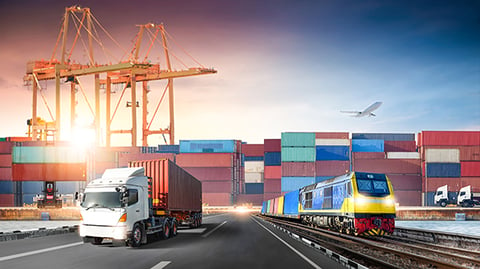
The U.S. transportation sector is constantly evolving to meet consumers’ needs and optimize business operations. While we probably won’t see flying vehicles anytime soon, there are a few new trends predicted to drive the freight transportation industry in 2024.
Nearshoring
The dynamics of trade in the U.S. are changing and will continue to shift in 2024. U.S. imports from China declined in 2023, resulting in an increase in imports from Mexico and Canada. Laredo, Texas, has emerged as a large entry point for truck and rail transportation between the U.S. and Mexico. With this increased traffic, potential congestion is anticipated for 2024.
Nearshoring provides numerous benefits, including reducing transportation costs. Since products do not have to travel as far to be imported, they can be delivered to consumers faster which is always appreciated. Nearshoring requires a reliance on trains, trucks, or both to transport goods. According to the Bureau of Transportation Statistics, trucks carried 55% of freight between the U.S. and Canada in 2022, and rail cars accounted for 16%. Trade with Mexico, however, relied even more on trucks, with 71% of freight being shipped by trucks and 12% by rail.
More Reliance on Railways
With the increased emphasis on nearshoring, Class I railways are positioning themselves to be more competitive in 2024. According to a freight trends report from Breakthrough, “The average intermodal train speed for all Class I railroads has increased by 5% compared to the same period last year.” Simultaneously, the report notes that the average terminal dwell time, which refers to the time a rail car spends in a terminal waiting to move to its destination, has decreased by 1%.
One exciting development for railways in 2023 was the creation of the first single-line railroad across Canada, the U.S., and Mexico. We could see more of this connectivity in 2024 as railways work diligently to enhance efficiency and provide opportunities to support the freight shipping industry.
Relying on railways means utilizing a variety of different rail cars. Read our blog post, Most Common Types of Rail Cars for Freight Shipping, to learn more.
Shipping Disruptions
It’s safe to say that no matter what year it is, the only thing for certain is uncertainty. This is especially true when assessing shipping challenges and global supply chains. Two areas to watch in this regard are the Panama Canal and the Suez Canal. Lower water levels due to drought in Central America are expected to continue in 2024, resulting in traffic restrictions in the Panama Canal. Additionally, maritime trade through the Suez Canal is predicted to remain a challenge in 2024 as major shipping lines divert routes due to Houthi-led attacks on cargo ships. This results in longer transit times and higher fuel expenses. This conflict also increases insurance costs due to the risk of theft. The insurance costs could be as high as 1% of the shipment value.
Increased Regulations
2024 is a milestone year for new government regulations in the transportation sector. The EPA is expected to release the final phase 3 heavy-duty vehicle emissions standards in the second quarter of 2024. These regulations impact the automotive industry by setting new emissions regulations and guidelines to follow when producing heavy-duty vehicles.
All eyes are also on California with the implementation of the Advanced Clean Fleet (ACF) regulation. Passed in 2023 to complement the Advanced Clean Trucks rule, the ACF act makes 2024 the year for large fleet vehicles to start the transition to zero emissions. The act mandates that 75% of medium and heavy-duty truck sales (class 4-8) must be zero-emission vehicles by 2036. Of that number, 40% are class 7 and 8 trucks weighing 26,001 pounds or more. This act has the potential to change the transportation industry with a surge in demand for electric or hydrogen-powered heavy-duty trucks.
Decrease in Fuel Prices
Oil and gas producers may not be thrilled, but consumers will rejoice knowing the U.S. Energy Information Administration expects U.S. gasoline and diesel prices to decline in 2024. This prediction is based on the expectation of lower demand growth with continued high production. The average gas price is anticipated to be around $3.40 per gallon in 2024 compared to $3.50 per gallon in 2023. Why do oil prices rise and fall? Find the answer and more in this blog post.
Technological Advancements
The transportation industry will continue to test and implement a wide range of new technology in 2024. For example, Kodiak Robotics Inc. introduced an autonomous truck at CES 2024, formerly known as the Consumer Electronics Show. Commercial trucks with Kodiak’s current technology are self-driving on freeways and then rely on an onboard safety driver to manually drive on local streets. The latest technology unveiled at CES removes the need for a safety driver. Autonomous vehicles involve the use of artificial intelligence (AI), but there are a plethora of other applications for AI in transportation, as well. AI can support dispatch and routing to help determine who should take which load and when. The technology can also be used for data protection and cybersecurity to identify potential vulnerabilities and shield operations from cyber threats.
Uncommon Excellence®
One trend you can count on every year is Dixon’s commitment to providing The Right Connection® for all sectors of the transportation industry. Whether it’s for cargo tanks, aviation, or rail tank cars, we strive to provide quality products built to last. For more information, visit dixonvalve.com or contact us at 877.963.4966.


